#Green Transportation India
Text

E Rickshaw Loader: Affordable and Efficient Solutions
Looking for an eco-friendly and cost-effective transportation solution? The e rickshaw loader is the answer. These versatile vehicles have revolutionized urban logistics with their affordability and efficiency. Understanding the e rickshaw loader price is crucial for businesses and individuals seeking to invest in this sustainable technology.
The e rickshaw loader price varies depending on several factors, including the features and battery capacity. Basic models are more affordable, while premium versions with extended battery life and advanced features might cost more. Despite the initial investment, the low running and maintenance costs make e rickshaw loaders a smart choice.
Additionally, government incentives and subsidies for electric vehicles can significantly reduce the e rickshaw loader price, making them even more accessible. These incentives aim to promote green transportation and reduce urban pollution, aligning with global sustainability goals.
Investing in an e rickshaw loader not only supports environmental conservation but also offers practical benefits like reduced fuel costs and lower maintenance expenses. As cities continue to embrace green technology, the demand for e rickshaw loaders is expected to rise, making now the perfect time to understand and leverage the best e rickshaw loader options.
#E Rickshaw Loader#E Rickshaw Loader Price#E Rickshaw Price in India#Electric Rickshaw Loader#Eco-friendly Transportation India#Affordable E Rickshaw#E Rickshaw Subsidies India#Green Transportation India#Urban Logistics Solutions#Cost-effective E Rickshaw#Low Maintenance E Rickshaw#Electric Vehicle Incentives India#Sustainable Transport India#E Rickshaw Battery Capacity#Urban Pollution Reduction#Electric Cargo Vehicles India#Indian E Rickshaw Market#E Rickshaw Loader Investment#Government Subsidies Electric Vehicles#Green Technology India
2 notes
·
View notes
Text
Blue Energy Motors: Leaders in the Manufacturing of Natural Gas Trucks
When it comes to transportation, the need for sustainable solutions has never been more pressing. As countries worldwide commit to reducing carbon emissions and mitigating environmental impact, the demand for eco-friendly alternatives is on the rise. Enter Blue Energy Motors, India's premier commercial vehicle manufacturer, revolutionizing the industry with its ground-breaking line of natural gas vehicles.

Natural gas vehicles (NGVs) are playing a huge role in transforming logistics. Blue Energy Motors stands at the forefront of this movement, pioneering the manufacturing of LNG-powered trucks in India. LNG, known as the cleanest burning natural gas in the world, has gained global recognition for its sustainability and significant carbon reduction benefits. Countries like the China and European Union have already reaped the rewards of adopting natural gas vehicles, and now, India is poised to follow suit.
Blue Energy Motors takes pride in being the first commercial vehicle manufacturer in India to manufacture LNG trucks domestically, bringing this cutting-edge technology to the country. These LNG-powered trucks play a pivotal role in India's journey towards carbon neutrality, aligning with the vision set forth by the Prime Minister. With India's commitment to achieving carbon neutrality by 2070, Blue Energy Motors' green trucks are instrumental in driving this ambitious goal forward.
What sets Blue Energy Motors apart is not just their commitment to green transportation, but also the remarkable performance and efficiency of their green trucks. These eco-friendly vehicles boast a range of up to 1400 kilometers per fill, offering exceptional fuel optimization without compromising on power or reliability. Moreover, Blue Energy Motors' green trucks deliver impressive reductions in CO2 emissions, slashing emissions by nearly 30%.
The environmental benefits extend beyond CO2 reduction. Blue Energy Motors' green trucks also boast a 100% reduction in SOx emissions, a 98% reduction in PM emissions, and a 30% reduction in sound pollution. These statistics underscore the profound impact of LNG-powered vehicles in creating a healthier planet. It is clear that Blue Energy Motors trucks are the best trucks in India.
As responsible truck manufacturers, Blue Energy Motors has ensured that their green trucks come equipped with advanced technological features designed to enhance safety and efficiency. The driving behavior monitoring system provides real-time alerts for over-speeding, harsh acceleration, harsh braking, or idle time, ensuring optimal performance and safety on the road.
Blue Energy Motors offers customized trucks tailored to the specific requirements of its clients. Whether it's bulker trucks, trailer trucks, or container trucks for industrial applications such as cement, clinker, steel, or fly ash, Blue Energy Motors has a solution for every need. Their trucks can be considered the best in India for clients seeking solutions in hard-to-abate industries.
As one of the best truck companies in India, Blue Energy Motors is paving the way for a greener planet. Their LNG-powered trucks will play a crucial role in driving India towards its carbon neutrality goals. In a rapidly evolving industry, Blue Energy Motors stands as the epitome of innovation, excellence, and environmental stewardship.
By embracing natural gas vehicles and championing green transportation, Blue Energy Motors is not just the manufacturer of the best trucks in India – they're the architects of a greener future.
For more: Blue Energy Motors: Leaders in the Manufacturing of Natural Gas Trucks
#natural gas vehicles#green transportation#best truck in india#commercial vehicle manufacturers in india#truck manufacturers#truck company in india
0 notes
Text
Top 5 Electric Bikes in India: Embracing Sustainable and Thrilling Rides
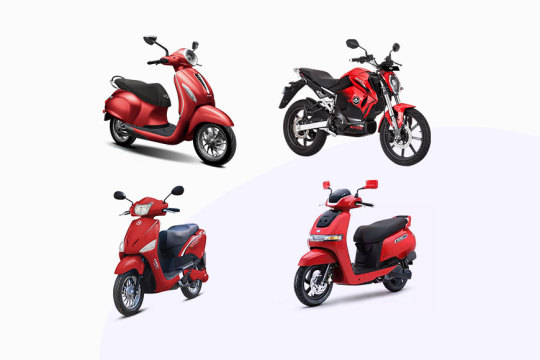
#Electric Bikes India#Eco Friendly Ride#Green Rides#Eco Friendly Transport#Electric Mobility#Sustainable Commute#Clean Energy Bikes#Future Of Transport#Go Electric#Zero Emissions#Electric Revolution#electric vehicles#electric bike#futuristic
0 notes
Text
Revving Up for Growth: Volkswagen Plans Major Expansion into India, Focusing on Electric SUVs!"
Volkswagen plans to revisit its strategy for India amid geopolitical uncertainty in China and sees India as a potential growth market.
German automaker Volkswagen (VW) plans to revisit its strategy for the Indian market amid geopolitical uncertainty in China. VW sees India as a potential growth market and is considering expanding its product range, particularly in the SUV segment. The company…

View On WordPress
#clean energy#Electric Vehicles#ev revolution#EVs#expansion#future of mobility#Green revolution#INDIA#sustainable transport#SUVs#Volkswagen
0 notes
Text
Emerald Spectacles from India, c. 1620-1660 CE: the lenses of these spectacles were cut from a single 300-carat emerald, and it was believed that they possessed mystical properties

These eyeglasses are also known by the name "Astaneh-e ferdaws," meaning "Gate of Paradise," based on the symbolic associations between the color green and the concept of spiritual salvation/Paradise. That symbolism (which is rooted in Islamic tradition) was especially popular in Mughal-era India, where the spectacles were made.

The lenses were crafted from two thin slices of the same emerald. Together, the lenses have a combined weight of about 27 carats, but given the precision, size, and shape of each lens, experts believe that the original emerald likely weighed in excess of 300 carats (more than sixty grams) before it was cleaved down in order to produce the lenses. The emerald was sourced from a mine in Muzo, Colombia, and it was then transported across the Atlantic by Spanish or Portuguese merchants.
Each lens is encircled by a series of rose-cut diamonds, which run along an ornate frame made of gold and silver. The diamond-studded frame was added in the 1890s, when the original prince-nez design was fitted with more modern frames.

The emerald eyeglasses have long been paired with a second set of spectacles, and they were almost certainly commissioned by the same patron. This second pair is known as "Halqeh-e nur," or the "Halo of Light."
The Halo of Light features lenses that were made from slices of diamond. The diamond lenses were cleaved from a single stone, just like the emerald lenses, with the diamond itself being sourced from a mine in Southern India. It's estimated that the original, uncut diamond would have weighed about 200-300 carats, which would make it one of the largest uncut diamonds ever found.

The lenses are so clear and so smoothly cut that it sometimes looks like they're not even there.
Both sets of spectacles date back to the mid-1600s, and it's generally believed that they were commissioned by a Mughal emperor or prince. The identity of that person is still a bit of a mystery, but it has been widely speculated that the patron was Shah Jahan -- the Mughal ruler who famously commissioned the Taj Mahal after the death of his wife, Mumtaz Mahal. Shah Jahan did rule as the Mughal emperor from about 1628 to 1658.
The emerald and diamond lenses may have been chosen for symbolic, sentimental, and/or cultural reasons, or they may have been chosen simply because they're pretty and extravagant; the original meaning and purpose behind the design is still unclear. Experts do believe that the eyeglasses were designed to be worn by someone, though.
At times, it was believed that the spectacles had spiritual properties, like the ability to promote healing, to ward off evil, to impart wisdom, and to bring the wearer closer to enlightenment. Those beliefs are largely based on the spiritual significance that emeralds and diamonds can have within certain Indic and Islamic traditions -- emeralds may be viewed as an emblem of Paradise, salvation, healing, cleansing, and eternal life, while diamonds are similarly associated with enlightenment, wisdom, celestial light, and mysticism.

The Gate of Paradise and the Halo of Light were both kept in the collections of a wealthy Indian family until 1980, when they were sold to private collectors, and they were then put up for auction once again in 2021. They were most recently valued at about $2 million to $3.4 million per pair.
Sources & More Info:
Sotheby's: Mughal Spectacles
Architectural Digest of India: At Sotheby's auction, Mughal-era eyeglasses made of diamond and emerald create a stir
Only Natural Diamonds: Auspicious Sight & the Halqeh-e Nur Spectacles
The Royal Society Publishing: Cleaving the Halqeh-Ye Nur Diamonds
Gemological Institution of America: Two Antique Mughal Spectacles with Gemstone Lenses
Manuscript: From Satan's Crown to the Holy Grail: emeralds in myth, magic, and history
CNN: The $3.5 million Spectacles Said to Ward off Evil
BBC: Rare Mughal Era Spectacles to be Auctioned by Sotheby's
#history#archaeology#artifact#mughal#india#17th century#art#emerald#diamond#glasses#indian lore#islam#religion#mysticism#indian history#anthropology#spirituality#fashion
5K notes
·
View notes
Text
This Week in Prophecy: Baghdad Turmoil; Russia & Iran, Rubles & Drones; Libya Civil War? Yangtze Drought, US Oil Emergency
This Week in Prophecy: 8/29/22
On This Week in Prophecy… Iraq is breaking down. Shia cleric Muqtada al-Sadr has announced he is stepping down from politics. The result is a violent power grab. The Green Zone is Baghdad is a war zone. The violence is spreading throughout the country. A nationwide curfew has been imposed. The United States appears to be air lifting personnel from their embassy…

View On WordPress
#Baghdad#china#Department of Transportation#drone#drought#electricity#flooding#food security#gas#Green Zone#hydroelectric#India#Iran#Iraq#IRGC#Muqtada al-Sadr#oil#Pakistan#rials#rubles#Russia#Saudi Arabia#US dollar#US Embassy#Yangtze river#yuan
0 notes
Text
This article isn't solely about the environment, but some of the things there are, so I'll summarize them for you :)
Bhutan and India boosted tiger numbers
According to Bhutan's latest tiger census, tigers have increased their population from 103 to 131 since 2015 - which is a rise of 27 per-cent.
This follows the country's major interventions to help the wild tiger population, including community based tiger conservation programmes, habitat improvement and human-wildlife conflict management projects.
Tigers are, of course, still at risk, but Bhutan's dedication to help and preserve their population is inspiring.
India has also reported a six pre-cent rise in their wild tiger population since last year. The country is believed to be populated by 3,682 tigers now.
Germany’s €49 travel pass
A part of a green new policy in Germany, a €49 (£42)-a-month pass allowing unlimited travel on buses and trains in Germany.
This will result in about 25 per-cent rise (per year) in the numbers of people choosing public transport instead of cars - a low carbon way of transport (according to the national rail operator Deutsche Bahn (DB)).
The Deutschlandticket launched on 1 May as a plan to lower the cost of living and encourage people to take the train instead of driving.
It seems to already have some great results: The Association of German Transport Companies says that almost 10 million people had used the pass by the end of June. DB has also said that trains to holiday destinations were busier this summer.
UK crop yields rose despite a fall in fertiliser use
New data from the UK’s Department for Environment, Food and Rural Affairs (Defra) revealed that UK crop yields rose last year, despite a sharp decline in fossil fuel fertiliser use. Many believed that these fertilisers were necessary, but this data proves that belief wrong.
According to Defra, wheat, barley, oilseed rape and sugar beet yields rose by 2.4 per cent in 2022, while fertiliser use fell by a reported 27 per cent.
These artificial fertilisers are made using natural gas, and because the prices soared in 2022, following Russia's invasion of Ukraine, farmers had to either use much less of them, or embrace more natural alternatives.
England’s plastic bag charge was hailed a success
Since the government in England forced supermarkets to charge 5p a plastic bag, there's been a 98 per-cent reduction of single use plastic bags.
That’s according to figures from the Department for Environment, Food and Rural Affairs, which introduced the charge in 2015, then increased it to 10p in 2021.
Environmental campaigners welcomed the figures, but urged the UK government not to row back on other green policies, including a deposit return scheme for plastic bottles and rules to make plastic producers contribute to clean-up costs. Both policies have been delayed until 2025.
Have a good weekend everyone!
Let me know, what good news have yo read or heard about lately?
#climate change#climate#hope#good news#more to come#climate emergency#news#climate justice#hopeful#positive news
198 notes
·
View notes
Text
Most books on the Bengal delta begin by describing it as “riverine,” [...] the land is the product of fluvial action [...]. [I]n thinking about Bengal, one tends to imagine the ricepaddy fields [...]. It was not so all the time; Bengal was never really a land of farming [...]. Traveling through Bengal in the eighteenth century, the French traveler Orme saw a highly sophisticated water-based economy - the blessing of rivers - irrigated [...] by the monsoon rains and annual flooding. [...] The rivers were not just channels of water; they carried a thriving trade, transporting people and goods from one part of the delta to another. Today, Bengal is generally seen as comprising lush green rice paddies [...]. Rivers are often presented as causing immense grief [through seasonal flooding] [...]. Clearly, there is a mismatch here. [...] How (and when) did Bengal’s social milieu transform from water-based to land-based? [...] Bengal’s essential character as a fluid landscape was changed during the colonial times through legal interventions that were aimed at stabilizing lands and waters, at creating permanent boundaries between them, and at privileging land over water, in a land of shifting river courses, inundated irrigation, and river-based life.
Such a separation of land and water was made possible not just by physical constructions but first and foremost by engineering a legal framework that gradually entered the popular vocabulary. [...] BADA, which stands for the Bengal Alluvion and Diluvion Act, [was] a law passed by the colonial British rulers in 1825, following the Permanent Settlement of 1793. [...] The environment of Bengal can be described as hybrid, where the demarcation between land and water is neither well-defined nor permanent. Nature here represents a borderless world, or at best one in which borders are not fixed lines on the ground demarcating a territory, but are negotiated spaces or zones. Such “[...] spaces” comprise “not [only] lines of separation but zones of interaction…transformation, transgression, and possibility” (Howitt 2001, 240).
---
Current boundaries of land and water are as much products of history as nature and the colonial rule of Bengal played a key role in changing the ideas and valuations of both. [...] The debate on what constituted productive and unproductive uses of land preceded the application of English property law not only to establish permanent zamindari (a common term for the system of landlordism) settlement of land tenure in India, but also to valorize land in what had essentially been a land-water hybrid environment. The colonial land revenue system, by seeing land as more productive (being able to yield revenue) and useful, began the long historical process of branding the rivers of Bengal as uncivil and in need of control. [...] The problem with deltaic land is its non-permanent nature, as silt is stored by rivers: rivers do not always flow along a certain route [...] The laws that the colonial British brought to Bengal, however, were founded upon the thinking of land as being fixed in place. [...]
---
Experiments to fine-tune the land-based economy began in 1760 when Bengal, and its ceded territories, came under the East India Company rule. [...] To entrench the system, the Permanent Settlement of 1793 created zamindars (or landlords) “in perpetuity” - meaning for good. The system was aimed at reducing the complexities of revenue collection due to erratically shifting lands and unpredictable harvests in a monsoon-dependent area [...]. Alarmed at the possibility of dismemberment of their estates, the zamindars decided to bind tenants to the same conditions to which they themselves were bound by the colonial government, and one of their actions was to create patni tenures or perpetual leases. [...]
It also meant that the right to collect rent from the tenants, often through the use of force, devolved to the lower layers, making the upper-layer zamindars more of a juridical rather than a real social entity in the eyes of the peasants. The patnidars, finding how much trouble this arrangement took off their own back, created dar-patnis or patnis of the second degree [...]. The dar-patnis created se-patnis or patnis of the third degree. The East India Company, therefore, had to legalize, through Regulation VIII of 1819, the creation of such formations, thus giving a de jure recognition post facto [...].
The regulation, although innocuous and simple, was of great historical potency: it became the key that unlocked the door to environmental and socio-economic changes of unparalleled magnitude. From a riverine community, within a hundred years, Bengal was transformed into a land-based community. [...]
---
The meaning of property also changed as a result of this law: the cultivators began to lose the right to occupy the land that they had enjoyed since ancient times because the colonial British had enumerated the characteristics of the zamindari property as an absolute right of proprietorship in the soil [...].
[T]he Company then began to contemplate the problematic issue of legalizing the fictional entities of chars [...]. The law that was created for this purpose -- and still rules the rights of ownership of charlands -- is the Bengal Alluvion and Diluvion Regulation Act (BADA) of 1825. [...] BADA was meant to establish a set of rules to guide the courts to determine the claims to land “gained by alluvion” or accretion, and the resurfaced land previously lost by diluvion or erosion. Even if one takes it for granted that chars are technically non-land in the sense that they exist within river banks, the difficulty remains that when a piece of land is lost to bank erosion, it may not arise in exactly the same location or arise at all within the foreseeable future. This means the owner has no certainty that they will get it back when it resurfaces or when another char rises nearby. [...] Thus, the key to establishing land rights in the court of law remained the payment of rent, even on diluviated land. [...] Such a rule will, however, not be applicable if a river suddenly changes its course and separates a considerable piece of land from one to join it with another farm, but without destroying the identity of the land so removed -- thus preventing legal recognition. New accretions in large navigable rivers would be the property of the state [...].
---
All text above by: Kuntala Lahiri-Dutt. “Commodified Land, Dangerous Water: Colonial Perceptions of Riverine Bengal.” In: “Asian Environments: Connections across Borders, Landscapes, and Times.” Edited by Ursula Munster, Shiho Satsuka, and Gunnel Cederlof. RCC Perspectives, no. 3, 17-22. 2014. [Bold emphasis and some paragraph breaks/contractions added by me.]
#summary of how britain took over bengal#calcutta#sundarbans#abolition#ecology#imperial#colonial#mangroves#tidalectics#archipelagic thinking#wetlands#ecologies#carceral geography#debt and debt colonies#caribbean#indigenous
248 notes
·
View notes
Text
Train fact: NAMED TRAINS!
So you've probably heard of the Flying Scotsman. Big green thing, turned 100 this year, probably the most famous locomotive in the UK, if not the world. Adapted into Thomas the Tank Engine with a whole lot of charisma and eyebrows. But did you know that name wasn't hers originally?
'The Flying Scotsman' is actually the name (formerly a nickname) of the train. The locomotive is Flying Scotsman's monster named for it. She was given the name in 1924, to help promote said service at the British Empire exhibition. Any engine, with any rack of coaches, or any train set, can be the Flying Scotsman.
Right now, it's run by LNER's new Azumas, which get a special little outfit about it:
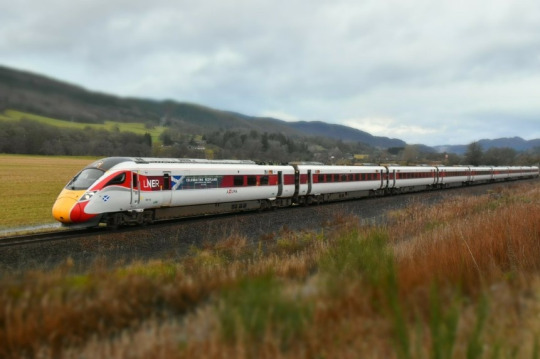
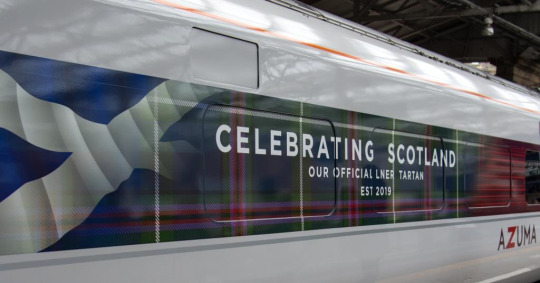
Most of the named trains in the UK were phased out with steam (although you can still catch the Sheffield continental from Sheffield to St. Pancras, or the Northern Lights from King's Cross to Aberdeen, among a handfull of others) but they live on elsewhere.
Some are luxury touring trains, like Japan's Seven Stars in Kyushu (left) or South Africa's Blue Train (right).


Transport isn't really the goal here. They sell out months in advance and cost anywhere from hundreds to thousands of dollars, depending on the class of ticket you get. They're an Experience, and a very cushy experience at that. Just look at their interiors!

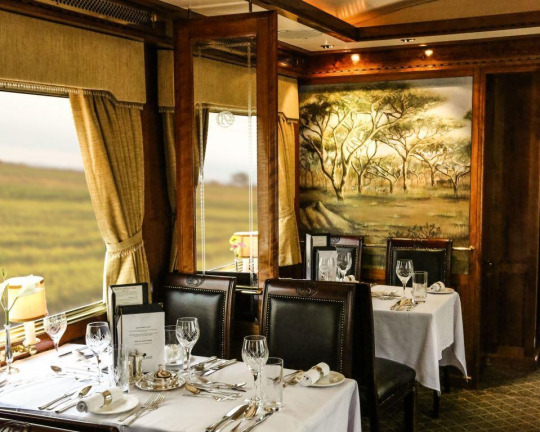
(yes, that's a piano)
But the vast majority of named trains in operation (as far as I can tell) are regularly-running exepress services across Asia.
Japan names their Shinkanens, India, Pakistan, Bengladesh & Sri Lanka often name their intercity expresses. These are practical, long-distance services, often named for monuments, like India's Ajanta Express, named for the Ajanta caves:
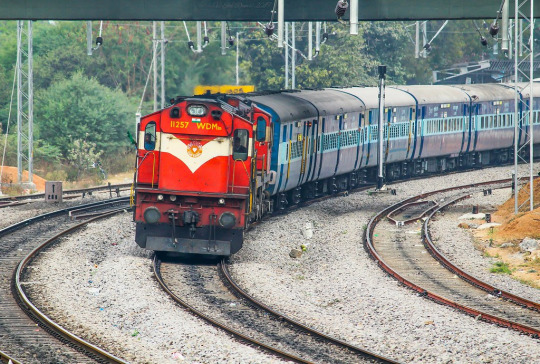
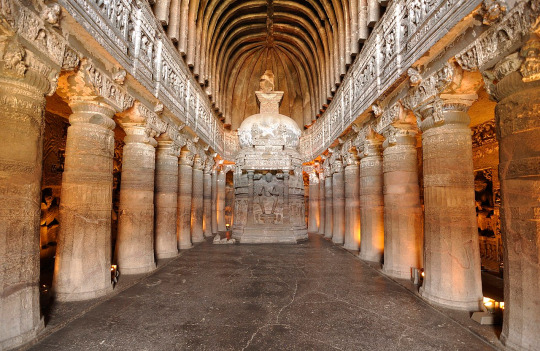
Or their operating regions, like Sri Lanka's උත්තර දේවී | Princess/Queen of the North:

Some North American countries also kept historic named routes, like Amtrak's Sunset Limited, or Canada's Ocean, which has operated continuously since 1904:

but my personal favorite named services are Australia's historically-nicknamed "The Fish", named after one of its drivers:

and the numerous trains that have been companion-nicknamed "The Chips" to match.
#Train facts!#ids in alt text#Sri Lanka Railways#LNER#modern LNER! Modern LNER! I know!#South Central Railway#Indian railways#NSW Train Link#via rail canada#the blue train#seven stars in kyushu#LNER Azuma
169 notes
·
View notes
Text

RideBoom, a leading innovator in the transportation industry, has exciting future plans in India to further revolutionize urban mobility and provide sustainable transportation options. Here are some of RideBoom's future plans in India:
Expansion of Bike Taxi Service: RideBoom plans to expand its highly successful Bike Taxi Service to additional cities in India [1]. This service aims to provide residents and visitors with an eco-friendly, efficient, and convenient mode of transportation for short-distance travel. The initial launch of the Bike Taxi Service has received a tremendous response, and RideBoom plans to introduce it in cities like Agra, Kolkata, and Pune [1].
Sustainable Transportation Solutions: RideBoom is committed to providing sustainable transportation solutions tailored to the needs of each community. By leveraging bike taxis as a primary mode of transportation, RideBoom aims to reduce traffic congestion, lower carbon emissions, and enhance the overall urban transportation experience [1].
Key Features of Bike Taxi Service: RideBoom's Bike Taxi Service offers several key features to ensure a seamless and convenient experience for users. These features include efficiency and speed, affordability, environmental sustainability, convenience and accessibility through the RideBoom mobile app, and safety and security measures for passengers [1].
RideBoom Premium: RideBoom plans to introduce RideBoom Premium, a new service tier that offers an elevated level of comfort and luxury to riders. This service will feature high-end vehicles, professional drivers, and personalized amenities, providing an exceptional travel experience [2].
Enhanced Safety Measures: Safety has always been a top priority for RideBoom, and they plan to implement additional safety measures in the future. This includes enhanced driver background checks, real-time trip monitoring, and improved emergency response protocols to provide an even more secure environment for riders [2].
Extended Service Areas: RideBoom aims to expand its service areas to reach even more cities and communities in India. By broadening their coverage, RideBoom intends to connect riders with reliable transportation options, regardless of their location [2].
Green Initiatives: As part of their commitment to sustainability, RideBoom plans to launch several eco-friendly initiatives. This includes the addition of electric and hybrid vehicles to their fleet and partnerships with environmental organizations to offset carbon emissions [2].
8 notes
·
View notes
Text
The EARTHSHOT PRIZE AWARDS 2022 Ceremony will take place at the MGM Music Hall at Fenway on December 2nd.
THE FINALISTS:
FIX OUR CLIMATE:
44:01 (Oman) - According to the UN, removing CO2 is essential if we are to limit global warming. Oman-based 44.01 removes CO2 permanently by mineralising it in rock.
LanzaTech (USA) - Carbon, released into the atmosphere, heats the planet. LanzaTech are using bacteria to recycle carbon pollution into profitable and sustainable products.
Low Carbon Materials (United Kingdom) - Concrete is responsible for an extraordinary eight percent of the world’s CO2 emissions. Now, thanks to UK based LCM, production could soon go from unclean to green.
CLEAN OUR AIR:
Ampd Enertainer (Hong Kong) - The construction industry is difficult to decarbonise and is one of the biggest drivers of air pollution. Ampd Energy has revolutionised the way we power construction.
Mukuru Clean Stoves (Kenya) - Across Africa, 700 million people use traditional cookstoves, which emit harmful chemicals and lack safeguards. Mukuru Clean Stoves are different.
Roam (Kenya) - The electric vehicle revolution is coming to East Africa. Roam is bringing affordable, electric transport to one of the world’s fastest growing regions.
BUILD A WASTE-FREE WORLD:
City of Amsterdam, Circular Economy (The Netherlands) - In 2020, The City of Amsterdam committed to becoming a circular economy. By 2050, it aims to waste nothing and recycle everything.
Fleather (India) - Flowers cast into the Ganges river contain highly toxic pesticides. Phool used this floral waste to make a sustainable alternative to leather.
Notpla (United Kingdom) - 6.3bn tonnes of untreated plastic waste currently litter our streets and fill our seas. Notpla shows us that the future is not plastic, it’s seaweed.
PROTECT & RESTORE NATURE:
Desert Agricultural Transformation (China) - The climate crisis means more of the Earth will become inhospitable desert. But now, thanks to Desert Agricultural Transformation, barren landscapes are turning into lush, green oases.
Hutan (Malaysia) - In Malaysian Borneo, research organisation Hutan is working with the local community to develop a more harmonious coexistence between its wildlife and people.
Kheyti (India) - Eight in ten of the world's farmers are smallholders. Beset by climate-affected harvests, Kheyti's Greenhouse-in-a-Box is helping them reduce climate risk and increase yields.
REVIVE OUR OCEANS:
Indigenous Women of the Great Barrier Reef (Australia) - The Great Barrier Reef is under constant environmental threat. Now, the Indigenous Women of the Great Barrier Reef are empowering each other to protect critical ecosystems.
SeaForester (Portugal) - Human activities and the climate crisis are decimating underwater seaweed forests. Pål Bakken and the SeaForester team are on a mission to restore them.
The Great Bubble Barrier (The Netherlands) - Every year, more than 8 million tonnes of plastic ends up in the world’s oceans. The Great Bubble Barrier's solution intercepts plastic waste before it reaches the sea.
94 notes
·
View notes
Text
Blue Energy Motors: Manufacturing the Best Commercial Vehicle in India
More and more companies are looking to incorporate sustainability within their operations. As a result, we are noticing a sharp rise in the demand for green technologies. Enter Blue Energy Motors, a frontrunner in green transportation in India.
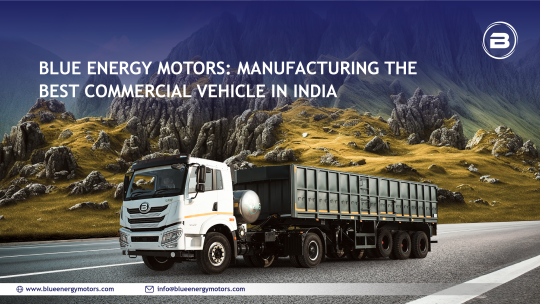
Blue Energy Motors prides itself on manufacturing state-of-the-art LNG trucks that not only deliver exceptional performance but also contribute significantly to environmental conservation. These trucks, powered by green fuel, have revolutionized the commercial vehicle manufacturing industry in India, earning the title of the best trucks in the country.
What sets Blue Energy Motors apart is their incredible commitment to sustainability and innovation. Dedicated to mitigating climate change through green transportation, the company has collaborated with several Fortune 500 firms, resulting in a combined reduction of over 2500 tons of CO2 emissions. To put this into perspective, their efforts are equivalent to planting a staggering 11,00,000 new trees—a testament to their dedication to environmental preservation. This has helped their trucks bag the title of “best trucks in India”.
The advantages of green trucking go beyond mere carbon emissions. Companies like Blue Energy Motors leave no stone unturned when it comes to addressing other critical environmental concerns. Their natural gas vehicles boast impressive statistics, reducing CO2 emissions by 30%, particulate matter (PM) emissions by 98%, and sulfur oxides (SOx) emissions by a remarkable 100%. Moreover, these eco-friendly vehicles slash noise pollution by 30%, offering a quieter and more peaceful transportation experience. As a result, many in the corporate world regard Blue Energy Motors as one of the most eco-friendly truck company in India.
It is easy to see that safety is of primary importance to Blue Energy Motors. Their natural gas vehicles are equipped advanced safety features. The trucks come with overspeeding, harsh acceleration, and harsh braking alerts, these vehicles prioritize the well-being of both drivers and pedestrians, ensuring a secure journey every time. They also provide access 24*7 access to command centres. These centres analyse data thoroughly and provide detailed reports so that you can take better decisions. Very few commercial vehicle manufactures in India ensure such care for their clients.
In addition to safety, Blue Energy Motors places a strong emphasis on reliability. Their advanced telematics system significantly reduces truck breakdowns by an impressive 75%, minimizing downtime and maximizing efficiency—a crucial indicator of excellence when it comes to choosing the right truck manufacturer.
There is no doubt that, Blue Energy Motors is the best truck company in India for businesses looking to lead the drive towards a healthier planet.
For more: Blue Energy Motors: Manufacturing the Best Commercial Vehicle in India
#natural gas vehicles#green transportation#eco friendly transportation#best truck in india#best truck company in india#best commercial vehicle in india
0 notes
Note
Oh good! Since you watched the movie already, these are the questions I would like to ask regarding The 40's reaction to it:
How do you think they'll react to Spider-Gwen's version of Peter Parker becoming The Lizard, his subsequent death, and Gwen being hunted down by her own father because of the misunderstanding?
How do you think they'll react to Miguel O'Hara's first appearance and seeing his performance as Spider-Man 2099?
How do you think they'll react to Spider-Gwen ultimately leaving her dimension after the terrible reveal of her identity to her father.
How do you think they react to The Spot's goofy behavior at the beginning and his attempts to become Miles' arch-enemy?
How do you think they'll react to Miles' growing tension with his parents as his activities as Spider-Man are getting in the way?
How do you think they'll react to Spot's multiversal hopping (Sony Venom's universe, LEGO, etc.), and the awkwardness of him saying his "holes"?
How do you think they'll react to Spider-Man India, his introduction, and his pet peeves of people saying "Chai Tea" and "Naan bread"?
How do you think they'll react to Spider-Punk aka Hobie Brown and his unique character design?
How do you think they'll react to The Spot becoming a multiversal being and his declaration of how he will take everything he loves from Miles, along with seeing a possible future of him decimating New York, murdering Jefferson, and even the Spider-Society?
How do you think they'll react to Miles, Gwen, Pavitr, and Hobie's incredible teamwork in saving Mumbattan?
How do you think they'll react to the Spider-Society, and seeing many characters in different shapes and sizes?
How do you think they'll react to Miguel O'Hara's workplace being a "slow" descent to create a dramatic effect?
How do you think they'll react to Peter B. Parker's return and his 1-year-old daughter Mayday?
How do you think they'll react to the idea of "Canon Events", seeing the many Spider-Men losing their "Uncle Ben" figures, "Police Captain" figures, the idea that they're allowing these "canon events" to pass to avoid universal destruction, and how it could possibly exist for their own worlds as well?
How do you think they'll react to Hobie's refusal to call himself a "hero" in his opinion, heroes are "self-mythologize narcissistic autocrats", and how that would apply to the Spider-Society?
How do you think they'll react to Miguuel's backstory of losing his alternate self's daughter and dimension because of him "breaking" a canon event?
How do you think they'll react to Miles being able to outrun the entire Spider-Society, his battle against an enraged Miguel, the reveal that he was never supposed to become Spider-Man in the first place, and being blamed by Miguel for blond Peter's death, and him "doing his own thing".
Do you think they would pick up the clues that Miles landed in the wrong universe before he "glitches"?
How do you think they'll react to the reveal of Miles' father being dead in Earth 42, being strapped to a punching bag as it looks like he's about to be tortured by Earth 42 Aaron, failing to convince him that he doesn't have to be the Prowler and nearly getting his face smashed by the gauntlet, and being confronted by his Earth 42 counterpart, whose currently the Prowler?
In general, how do you think they'll react to the fact that the Miles Morales they were watching was actually meant to become a supervillain instead and that his Earth 42 counterpart is the one the became Spider-Man if it weren't for the collider of the first movie transporting the spider just as it was about to bit Earth-42 Miles in the place where Miles and his uncle were spraypainting. There's plenty of evidence that foreshadows this as seen in Into the Spider-Verse, Miles' spider-sense colors when he first meets blond Peter was green and purple before changing to red and blue, and how he smirks when looking out the window of his dorm when coming up with an idea of what to write for his assigned paper of becoming in the future and the next shows his uncle, Aaron, and the colors of his face during his confrontation with his Earth 42 counterpart having more purple than the red and blue. By contrast, Earth-42 Miles' visor was showing purple in color before zooming into Miles' face and the colors changing to red and blue, the fact that any purple being shines on Earth-42 Miles is more due to external sources showcases how his hellish environment has to harden him into becoming the Prowler instead of Spider-Man, and when he reveals his face to Miles, the blue and red coloring on the sides of his face is greater than the purple in the middle. For more irony, Earth-42's brief appearance in The Spot's recollection of the spider has him studying in a classroom, implying that he's a driven and hard-working student trying to make his living conditions better while Miles was blowing off his own homework to spray paint with his criminal uncle.
1.
Would feel bad for both Peter and Gwen, as the former was pushed to the point while the latter is both terrified of her father, who was still trying to arrest her and still pointed a gun at her.
Some may understand the need to be brutal, but to do so to a teenager, and innocent one at that, is going too far.
Would feel terrible for her because after the confrontation and how her father was still acting as an officer would break their hearts.
They would see him as trying a bit too hard, but are still wary since his ability can be very versatile.
Can’t help but feel sympathy for Miles, but they understand where his parents are coming from as well.
Impressed by his powers and the multiple dimensions, and will not try to laugh at him being awkward.
They would find him a really good person and glad to see he is doing so much to protect his home. (But would get a giggle over his pet peeves)
Some might be put off by it, but most of them would love it.
Would hate the Spot at this point, seeing that he is too far gone and would hope that the heroes can stop him in time.
Would be cheering for them every step of the way and would love how well they work together.
Amazed
Find it a little bit awkward.
Be happy to see that he is doing better and is being a positive influence on Mayday.
They would hate the idea of it allowing those events to happen. They know that a universe “could” be at stake, but if they have the chance to change something, they can’t just stand on the sidelines.
A little taken aback, but given what they have seen of him thus far, it makes sense
They would understand that what he is doing is a trauma response, but everything that happened to him doesn’t hold up well in the face of everything that happened, since he doesn’t have sufficient evidence.
They would be impressed and then would be enraged by Miguel for trying to place blame onto Miles, calling it out as self-projecting.
Yes
Would be saddened to see that this is how Miles could have been and hope that he gets rescued soon.
They know it was an accident, but after seeing Miles’s journey, they are glad that he became a hero. Of course they are shocked to find out, but to see Miles making his own choices would make them proud.
#main character syndrome (with exceptions)#the 40#the_ravenclaw_werewolf#ask & answer#omnitheist27#spiderman#into the spiderverse#across the spiderverse#miles morales#gwen stacy#peter b parker#hobie brown#pavitr prabhakar#miguel o'hara#the spot
21 notes
·
View notes
Text

How Technology Is Impacting The Mumbai Real Estate Market
Properties in Mumbai, from small residential or retail spaces to large industrial or commercial business complexes, offer a wide varieties and constantly launching new projects. Technology is playing a significant role in both the residential and commercial sectors of Mumbai. Many developers are introducing smart home technologies into their new projects, allowing residents to enhance their lifestyles and fulfill their expectations. Here are the major types of technologies used in Mumbai's real estate industry:

Reliable Power & Internet Services
With a population of around 21 million in 2024, Mumbai faces a high demand for electricity, internet, and other services. Developers in Mumbai have introduced partnerships with private sectors like Reliance Electricity, Tata Power, Airtel Internet, and Jio Fiber to meet these demands. This reliable supply of energy and services ensures residential needs are met and allows Corporates & Industries to function at their full potential.
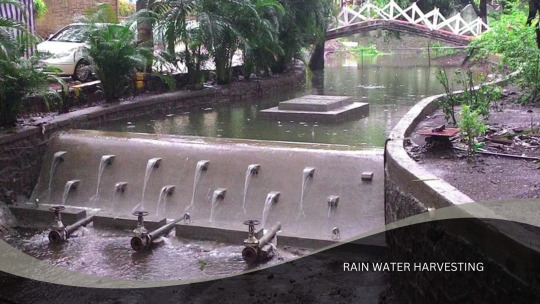
Go Green Technology (Reduce, Reuse & Recycle)
Over the past two decades, Mumbai has become India's most visited city and a growing population hub. This rapid growth has put a strain on resources like water and green spaces. To address this, many Mumbai projects are incorporating green features. These include the development of artificial mangroves, large-scale gardens, and lakes to preserve nature and provide a fresh environment for residents. Additionally, property developers are introducing rainwater harvesting, Water filtration plants and garbage restoration services to their communities, promoting sustainability through reduction, reuse, and recycling.

Connectivity & Transportation Infrastructures
Mumbai is known for its fast-paced lifestyle, and large-scale property development is a constant feature. To improve connectivity, new infrastructure projects like the Worli Sea Link and Atal Setu Bridge connect major parts of the city to suburbs and prime locations. Additionally, Mumbai's new metro lines, mono trains and the prime railway network provide greater comfort and convenience for daily commuters. Modernization of the railways with new trains reduces congestion and offers safer journeys.
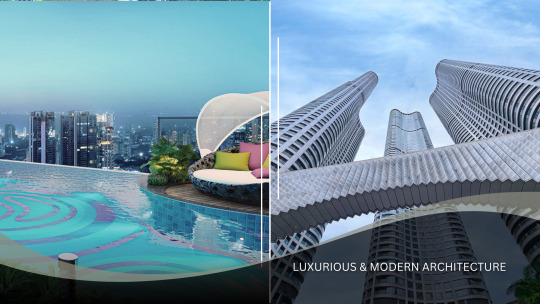
Modern Engineering & Luxurious Architecture
High-volume investors demand luxury and spacious living environments. Modern designs present a challenge ie. building architectural marvels in fast-growing areas with limited land. Technologies like heavy mobile cranes, temporary concrete plants and high-speed elevators facilitate the construction of modern real estate. In the luxury segment, glass-finished projects dominate central Mumbai areas like Parel-Worli to SoBo areas Dadar-Juhu. These buildings, constructed with modern glass manufacturing technology, add a glow to the city skyline. This lightweight and durable material is low-maintenance and withstands various weather conditions. Many engineering marvels include rooftop amenities like infinity pools, helipads, and vertical parking systems, catering to the luxurious needs of residents.
here's a Conclusion Technology giving boosts to mumbai's real estate market, by growing investors attentions towards good services, modern amenities, fast transportation & Smooth Connectivity. Providing Comfort & safety to Residents & sustainablity to limited Resources.
#real estate technology trends#mumbaiproperties#mumbairealestate#mumbai#dreamhome#propertyfinder#luxuryliving#mumbai infrastructure#tech used in architecture#technoloy in modern construction#sunblonde realtors#sunblonde realty#realestate
2 notes
·
View notes
Text
Green Living Made Easy: Eco Shopping Tips
Live a Greener Life: Sustainable Shopping and Living Tips with Brandfinity
Brandfinity, a leading branding and marketing agency in India, is committed to promoting eco-conscious practices. In line with this mission, we present these valuable tips to help you make sustainable choices in your everyday shopping and living:
Embrace Sustainable Materials for Clothing and Home Goods:
Opt for eco-friendly options: Look for clothing and home goods made from organic cotton, hemp, or bamboo. These materials often require less water and fewer chemicals compared to conventional options.
Reduce waste, support circularity: Choose products made from recycled or upcycled materials. This not only minimizes waste but also promotes a circular economy where resources are reused.
Support Local and Organic Produce:
Reduce your carbon footprint: Opt for locally grown fruits and vegetables. This not only supports local farmers but also reduces the environmental impact of transportation.
Prioritize health and a healthy planet: Choose organic produce to avoid harmful pesticides and synthetic fertilizers that can negatively affect your health and the environment. Organic farming practices promote soil health, biodiversity, and water conservation.
Minimize Waste with Reusable Bags and Containers:
Ditch the plastic: Invest in reusable shopping bags made from durable materials like canvas or recycled materials. This eliminates the need for single-use plastic bags, significantly reducing waste.
Embrace reusables for bulk items: Utilize reusable containers when buying bulk items like grains, nuts, and spices. This eliminates the need for single-use packaging, further minimizing waste. Remember to wash and sanitize your reusable bags and containers regularly.
Champion Eco-Friendly Brands and Products:
Look for certifications: Support brands and products with certifications that showcase their environmental commitment, such as organic, fair trade, or cruelty-free labels. These certifications ensure adherence to specific standards and minimal harm to the environment and workers.
Sustainable practices matter: Choose brands that prioritize sustainability throughout their supply chain, from sourcing materials to manufacturing and packaging. By supporting these brands, you encourage more sustainable business practices with your purchasing power.
Embrace Sustainable Fashion with Second-Hand and Thrift Shopping:
Reduce demand, extend lifespans: Consider second-hand and thrift stores for unique and stylish clothing at affordable prices. This reduces the demand for new clothing production and gives pre-loved items a second chance.
Promote a circular fashion economy: By choosing second-hand fashion, you contribute to a circular economy by extending the lifespan of clothing and minimizing textile waste. Don't forget to donate or sell your own unwanted clothing to keep the cycle going!
Live a greener life, one sustainable choice at a time!
Partner with Brandfinity to craft an eco-conscious brand identity and marketing strategy that resonates with your sustainability goals. Visit us at https://brandfinity.ch/en/ to learn more.
#business#wix#logo design#ui ux design#cms development services#marketing#web developer#website#e commerce#education
3 notes
·
View notes
Text
Akshay Mehndiratta: Best Restaurants In Delhi That Must Try Once In 2024

Delhi, the bustling capital of India, is one region where you will find foodies. Along with the variety of Indian food, residents of Delhi are also experiencing various flavors. From classic Indian cuisine to global cuisine, the city offers an endless exploration of tastes. If you consider yourself a true foodie, discovering new foods is probably a constant endeavor. However, in an ever-expanding culinary landscape, choosing where to eat can be a daunting task. In this guide created by foodie and Delhi food explorer Akshay Mehndiratta, we tell you about some of the restaurants in the city for 2024 that will fill your stomach.
Dum Pukht, Delhi
Embark on a culinary journey through the royal kitchens of Awadh at Dum Pukht, located within the grand confines of ITC Maurya. Known for its slow-cooked dishes and regal ambiance, Dum Pukht takes diners to a world of indulgence and extravagance. Enjoy aromatic biryani, juicy kebabs and rich gravies, all carefully prepared using age-old techniques and premium ingredients. Whether you’re celebrating a special occasion or simply looking for a taste of luxury, Dum Pukht promises an unforgettable dining experience. Akshay suggests enjoying the royal taste of Mehndiaratta Dum Pukht.
Location: ITC Maurya, Chanakyapuri, Delhi
Indian Accent, Delhi
Indian food is considered rich and delicious. The modern avatar of Indian cuisine created by Chef Manish Mehrotra is a revelation. He is a talented person who tries to give new look to his regular staff every week. He is innovative and stays within the bounds of authenticity and offers dishes like the Pulled Jackfruit Phulka Taco which is basically a jackfruit wrap. Duck Khurchan Cornetto and Aloo Gole Chaat is an amazing dish. Pavbhaji tastes amazing with ricotta bread. Tamarind Fish with Coconut Barley is reminiscent of coastal ghats, delighting in every bite. Every creation at Indian Accent is a masterpiece, a must-try for foodies in 2024. Akshay Mehndiratta recommends trying their special dishes.
Location: The Lodhi, Lodhi Road, Delhi
Bukhara, Delhi
For those looking for a rich taste of North-West Frontier cuisine, ITC Maurya in Bukhara is the best place to dine. Famous for its rustic charm and timeless dishes cooked in a traditional tandoor, Bukhara offers a culinary journey into the past. Juicy Kebabs, Fragrant Biryani that tickle your tongue, all the dishes here are prepared from the finest ingredients and taste incredible. Food in Bukhara is not just about satisfying hunger; It’s a sensory experience that stays with you long after you’ve had the last experience. Akshay Mehndiratta strongly recommends experiencing the rustic charm of Bukhara.
Location: ITC Maurya, Chanakyapuri, Delhi
Spice Route, Delhi
Located in the vibrant heart of Delhi, Spice Route takes you on an exciting journey through the diverse and exotic flavors of Asia. Inspired by ancient spice trade routes, the restaurant creates a menu that celebrates the continent’s rich culinary heritage. From aromatic Thai green curry to spicy Sichuan kung pao chicken and fragrant Indonesian nasi goreng, each dish is a harmonious blend of flavors and spices, carefully crafted to tantalize the taste buds. As diners embark on this culinary journey, they are transported to a distant land by the restaurant’s exotic decor adorned with stunning artwork and artifacts. Spice Route offers an unforgettable dining experience, where every meal is a celebration of the vibrant and diverse cuisines of Asia. Akshay recommends exploring the vibrant flavors of spice roots.
Location: The Imperial Hotel, Janpath, Delhi
Dakshin, Delhi
Located in the heart of Delhi, South invites diners on a culinary journey along the southern coast of India. The restaurant is renowned for its authenticity and flavours, celebrating the rich and diverse culinary heritage of South India. From the tamarind-rich Chettinad cuisine to the coconut-infused dishes of Kerala and the spicy flavors of Andhra Pradesh, the south has a variety of flavors and aromas that reflect the essence of the region. Enjoy signature dishes like aromatic Hyderabadi biryani, crispy masala dosa and creamy avial, each prepared with precision and passion. Against a backdrop of traditional decor and warm hospitality, Southern offers a dining experience that is as luxurious as it is soulful, making it a favorite destination for lovers of South Indian cuisine in Delhi. Try his recipes for this unique culinary experience, says Akshay Mehndiratta.
Location: Welcome Hotel Sheraton, Saket, Delhi
Moti Mahal, Delhi
Located in the heart of Delhi, Moti Mahal is a testament to the rich culinary heritage of North India, particularly known for its pioneering contribution to Tandoori cuisine. With decades of heritage, Moti Mahal has earned a prestigious name for its exquisite cuisine that has become synonymous with Indian cuisine. From the smoky aroma of their signature tandoori chicken to the creamy richness of their butter chicken, each dish is crafted with precision and passion, paying homage to tradition while embracing innovation. With a beautiful ambience filled with warmth and hospitality, Moti Mahal invites diners to take a delicious journey into the heart of Indian cuisine, making it a favorite culinary destination for both locals and tourists. Akshay Mehndiratta suggests experiencing the old charm of Moti Mahal
Location: Netaji Subhash Marg, Daryaganj, and others, Delhi
Conclusion
Whether you are a culinary connoisseur or love to explore new flavours, Akshay Mehndiratta says that these restaurants offer an unforgettable gastronomic experience in the heart of Delhi. From traditional Indian cuisine to international cuisine, each establishment offers a unique glimpse into the rich tapestry of flavors that define the capital’s culinary identity. So, whet your appetite and embark on a culinary adventure through Delhi’s vibrant food scene!
2 notes
·
View notes